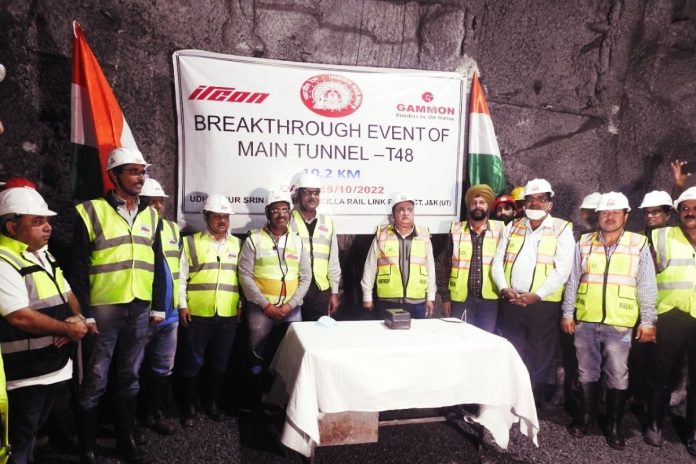Snapshot
Out of the total 272 km length of USBRL project, 161 km has already been commissioned and operationalised.
The other three transportation tunnel (T-49, T-15 and Pirpanjal tunnel) are also part of this project.
In another milestone achievement, the Railways has executed break-through of 10.18 km long tunnel in the Kashmir rail link project.
Known as T-48, the fourth longest tunnel of Indian Railways, is situated between Sangaldan and Sumber stations on the ongoing Katra-Banihal Section of the Udhampur-Srinagar-Baramulla Rail Link (USBRL) project.
With the successful completion of the tunneling work, prolonged for various reasons, a major bottleneck was removed in the Katra-Banihal section.
Describing the breaking through of the tunnel between Sangaldan and Sumber stations “as a big achievement in the USBRL project”, Northern Railway General Manager Ashutosh Gangal said the major milestone was achieved on 18 October.

The line and level of the tunnel are precisely achieved during the breakthrough of T-48. It is a modified horseshoe-shaped tunnel connecting the Sumber Station yard on the North side and Bridge No.1 over Chinji Nallah on the South side, at Dharam village.
The Tunnel T-48 is a twin tube tunnel comprising the main tunnel and Escape Tunnel (9.788 kms) connected with 24 cross-passages.
The tunnel is constructed as per International standards, in which provision of an Escape Tunnel has been made to facilitate rescue and restoration works in emergency cases.
The South drive from Dharam is the longest drive at 3,940 mts., thereby making it the most difficult drive for carrying out mining work and maintaining a well-ventilated face for working.
Also, the North drive remained difficult due to the continuous pumping of water from inside the tunnel towards the North Portal as the drive is on a falling gradient.
The tunnel has been constructed by the New Austrian Tunneling Method (NATM), which is a modern technique of drill and blast processes. The construction work has been entrusted to IRCON International by Northern Railway.
Although the boring work of the tunnel started from both directions up to the hand-shaking point, the precision of both ends meeting at one point flawlessly is a joint effort of Northern Railways and IRCON.
This is the result of meticulous planning and precise execution of tunneling work, the line and level of the tunnel perfectly matched in both portions after the break-through.
The team of experienced engineers of Northern Railway, IRCON, and the executing agency Gammon successfully negotiated all challenges and achieved the major milestone.
During the construction activities of the tunnel, more than 70 per cent of workers from nearby villages were engaged in various construction activities, thereby ushering a positive change in the overall socio-economic landscape of the region.
Out of the total 272 km length of USBRL project, 161 km has already been commissioned and operationalised. The work of balance 111 kms, the intervening stretch between Katra-Banihal is under progress at a rapid pace.
Katra–Banihal section is traversing through the hilly terrain of the lower Himalayas in which weak geology, remoteness and inaccessibility of the area, weather conditions, landslides, and shooting stones on access roads are major challenges.
It has several major bridges and very long tunnels which are under construction at different stages.
It is worthwhile to mention that the T-48 tunnel is the fourth longest transportation tunnel in the country and all the other three tunnels are also part of this project.
- T-49 is 12.75 km between Sumber–Khari stations
- T-15 is 11.25 km between Sangaldhan–Basindhadar stations
- Pirpanjal Tunnel is 11.2 km between Banihal–Qazigund stations


